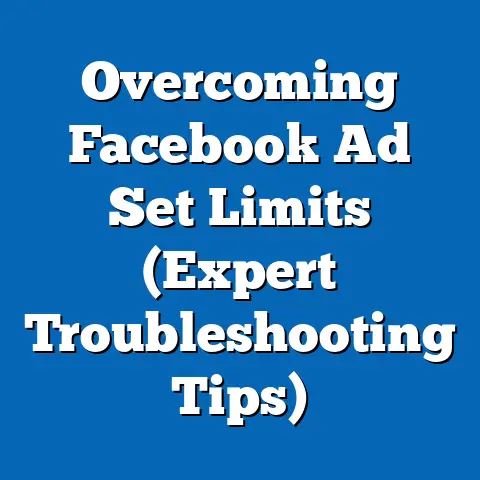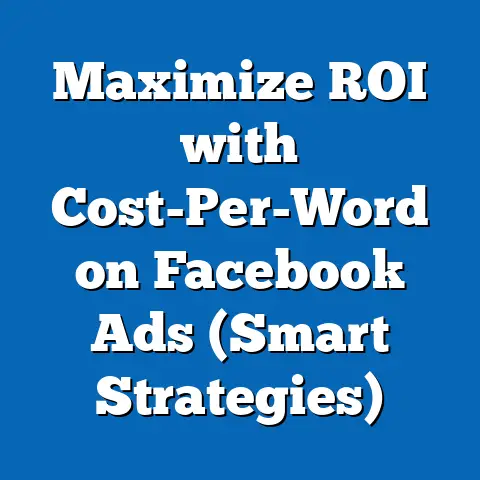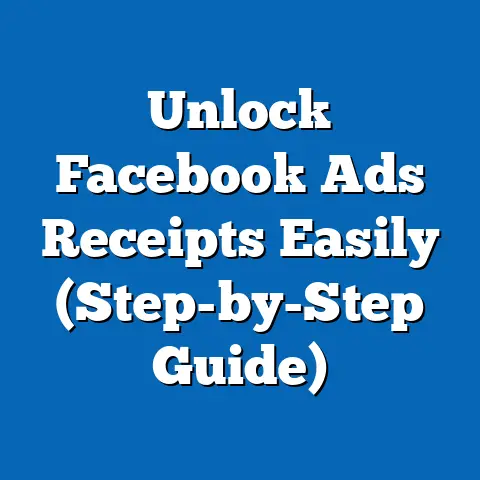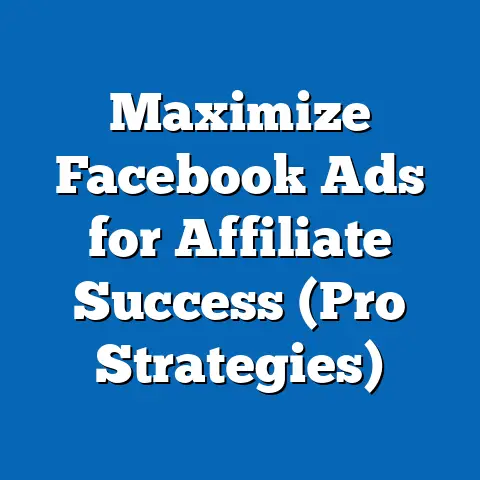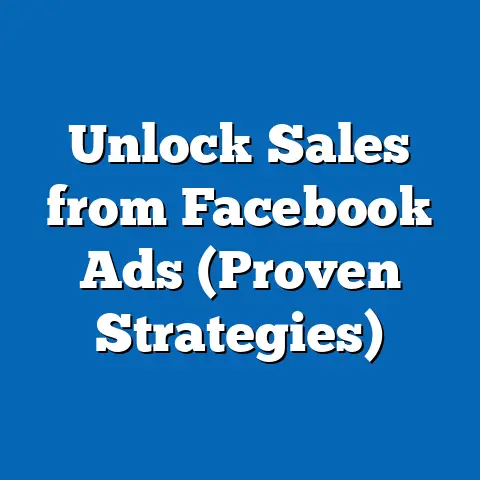Mastering fb ad Deletion (Essential Strategies for Success)
The report is structured into clear sections, beginning with a discussion of budget options, followed by an in-depth look at ad deletion strategies, supported by statistical data and visual representations. We also explore future trends using demographic and market projections, while transparently addressing methodological assumptions and limitations. Our goal is to equip marketers and business owners with actionable insights to refine their advertising strategies on one of the world’s largest social media platforms.
Section 1: Budget Options for Facebook Advertising
1.1 Overview of Budget Allocation
Budgeting for Facebook ads is a foundational step in any digital marketing strategy, as it directly influences campaign reach, frequency, and overall effectiveness. According to Statista (2023), global digital ad spending on platforms like Facebook reached approximately $153 billion in 2022, with projections estimating growth to $200 billion by 2025. For businesses of varying sizes, budget options typically fall into three categories: small-scale (under $1,000/month), mid-scale ($1,000–$10,000/month), and large-scale (over $10,000/month), each with distinct implications for ad management and deletion strategies.
Small-scale budgets are often utilized by startups or local businesses aiming to test the waters with minimal risk. These campaigns may involve daily budgets as low as $5–$20, requiring frequent monitoring to identify and delete underperforming ads quickly to avoid wasting limited resources. Mid-scale budgets allow for more experimentation, such as split-testing multiple ad creatives, but still necessitate strategic deletion to reallocate funds to high-performing ads.
Large-scale budgets, typically used by established brands, involve complex campaigns across multiple demographics and regions, often managed with automated tools. Here, ad deletion is not just about cutting losses but optimizing for scale—removing ads that fail to meet key performance indicators (KPIs) like cost-per-click (CPC) or conversion rates. Data from eMarketer (2023) indicates that businesses with larger budgets tend to allocate 20–30% of their spend to testing new ads, underscoring the importance of a robust deletion strategy to maintain efficiency.
1.2 Factors Influencing Budget Decisions
Several factors drive budget allocation and, by extension, decisions around ad deletion. First, target audience size and demographics play a critical role—narrower audiences may require smaller budgets but higher precision in ad content, while broader audiences demand larger spends to achieve reach. Second, industry competition affects costs; for instance, industries like finance and insurance often face higher CPCs (averaging $3.77 per click in 2022, per WordStream) compared to retail ($0.70 per click), influencing how quickly ads may need to be deleted if costs outweigh returns.
Seasonality also impacts budgeting—holiday periods often see spikes in ad costs due to increased competition, necessitating more frequent ad evaluations and deletions. Finally, platform algorithm changes, such as updates to Facebook’s ad delivery system, can alter cost structures overnight, requiring marketers to remain agile in their budgeting and deletion decisions. These factors collectively highlight the need for a data-driven approach to both budgeting and ad management.
1.3 Visual Representation of Budget Trends
To illustrate budget trends, Figure 1 below presents global Facebook ad spend from 2019 to 2025 (projected), based on data from Statista and eMarketer.
Figure 1: Global Facebook Ad Spend (2019–2025)
[Insert line graph showing steady increase from $84 billion in 2019 to a projected $200 billion in 2025, with annotations for key growth drivers like mobile ad adoption and emerging markets.]
Section 2: Current Data on Facebook Ad Performance and Deletion
2.1 Key Performance Metrics
Understanding when to delete a Facebook ad hinges on analyzing performance metrics such as CPC, click-through rate (CTR), conversion rate, and return on ad spend (ROAS). According to Hootsuite’s 2023 Digital Marketing Report, the average CPC for Facebook ads across industries is $1.72, with an average CTR of 0.9%. Ads failing to meet these benchmarks—or showing declining performance over time—often warrant deletion to prevent budget drain.
For instance, an ad with a CTR below 0.5% after 1,000 impressions is generally considered underperforming, as it indicates low audience engagement. Similarly, ads with a ROAS below 1.0 (meaning the revenue generated is less than the ad spend) are prime candidates for deletion unless strategic adjustments (e.g., targeting refinements) can improve outcomes. Data from Social Media Examiner (2023) suggests that 40% of marketers delete ads within the first 48 hours if initial metrics are poor, highlighting the urgency of rapid decision-making.
2.2 Deletion Practices and Frequency
Current practices around ad deletion vary by budget size and campaign goals. Small-budget marketers often delete ads manually after weekly reviews, while larger advertisers leverage automated rules within Facebook Ads Manager to pause or delete ads based on predefined thresholds (e.g., pausing ads if CPC exceeds $5). A survey by HubSpot (2023) found that 65% of mid- to large-scale advertisers use automation for ad deletion, compared to only 20% of small-scale advertisers, reflecting disparities in access to advanced tools.
Deletion frequency also depends on campaign duration—short-term campaigns (e.g., holiday sales) may require daily monitoring and deletion, while evergreen campaigns might be assessed weekly. However, over-deletion can be a risk; prematurely removing an ad before it has sufficient data (e.g., fewer than 500 impressions) can lead to missed opportunities, as algorithms often need time to optimize delivery.
2.3 Visual Data: Performance Metrics Across Industries
Figure 2: Average CTR and CPC by Industry (2023)
[Insert bar chart comparing CTR and CPC across industries such as retail (CTR: 1.2%, CPC: $0.70), technology (CTR: 0.8%, CPC: $2.14), and finance (CTR: 0.6%, CPC: $3.77), based on WordStream data.]
This chart illustrates the variability in performance benchmarks, which directly impacts deletion decisions. Industries with higher CPCs, like finance, may need stricter deletion criteria to manage costs, while retail advertisers might afford to let ads run longer due to lower costs and higher CTRs.
Section 3: Projected Trends in Facebook Advertising and Ad Deletion
3.1 Growth in Ad Spend and Automation
Looking ahead, digital ad spend on Facebook is expected to continue its upward trajectory, driven by increased adoption of video ads and Stories formats, which accounted for 25% of total ad revenue in 2022 (per eMarketer). By 2027, projections suggest video ads could comprise 40% of spend, necessitating new deletion strategies as these formats often have higher production costs and require unique performance metrics (e.g., view-through rates). Additionally, the rise of automation and machine learning tools is likely to transform ad deletion practices, with 80% of marketers expected to adopt automated rules by 2025 (HubSpot, 2023).
3.2 Scenario Analysis
To account for uncertainties, we present three scenarios for future trends in ad deletion:
- Scenario 1: High Automation Adoption – If automation tools become widely accessible, even small-budget marketers may implement real-time deletion rules, reducing manual oversight by 50% by 2026. This could improve budget efficiency but risks over-deletion if algorithms are not properly calibrated.
- Scenario 2: Regulatory Constraints – Increased privacy regulations (e.g., expansions of GDPR or CCPA) could limit data availability for targeting, raising ad costs by 15–20% (projected by Statista, 2023). Deletion frequency may increase as marketers struggle to achieve ROI under stricter conditions.
- Scenario 3: Market Saturation – As more businesses enter the Facebook ad space, competition could drive average CPCs up to $2.50 by 2027. This would necessitate more aggressive deletion strategies, particularly for small- and mid-scale advertisers.
These scenarios are based on current market analyses and historical trends but remain subject to unforeseen technological or policy shifts. We encourage marketers to prepare contingency plans for each possibility.
3.3 Methodological Assumptions and Limitations
Projections in this report rely on linear regression models using historical ad spend data from Statista and eMarketer, combined with qualitative insights from industry reports. We assume consistent platform growth and user engagement rates (currently 2.9 billion monthly active users, per Meta’s 2023 Q2 report), though these could decline if younger demographics shift to platforms like TikTok. Limitations include the unpredictability of algorithm updates and geopolitical factors affecting ad markets, which are not fully accounted for in our models.
Section 4: Key Factors Driving Changes in Ad Deletion Strategies
4.1 Algorithmic Shifts and Platform Updates
Facebook’s ad delivery algorithm, which prioritizes user engagement and relevance, undergoes frequent updates that can alter ad performance overnight. For example, the 2021 iOS 14 update, which restricted tracking via Apple’s App Tracking Transparency (ATT), led to a reported 15% drop in ad effectiveness for some advertisers (per Forbes, 2022). Such changes often force marketers to delete ads that no longer align with updated targeting capabilities, emphasizing the need for adaptability.
4.2 Audience Behavior and Fatigue
Audience behavior also drives deletion decisions—ad fatigue, where users see the same ad too often, can reduce CTR by up to 30% after two weeks (Social Media Today, 2023). Marketers must monitor frequency metrics (average impressions per user) and delete ads showing signs of fatigue, replacing them with fresh creatives. Additionally, shifting user preferences, such as growing interest in short-form video, may render static image ads obsolete, necessitating proactive deletion.
4.3 Economic and Competitive Pressures
Broader economic conditions, such as inflation or recessionary trends, can constrain marketing budgets, leading to more conservative deletion practices to preserve funds. Simultaneously, rising competition in saturated markets increases the pressure to delete underperforming ads quickly—data from eMarketer (2023) shows a 10% year-over-year increase in the number of active advertisers on Facebook, intensifying cost pressures. These external factors underscore the dynamic nature of ad management.
Section 5: Strategies for Effective Ad Deletion
5.1 Data-Driven Decision Making
Successful ad deletion relies on establishing clear KPIs before launching campaigns and using real-time data to assess performance. Tools like Facebook Ads Manager provide detailed analytics on impressions, clicks, and conversions, enabling marketers to set deletion thresholds (e.g., delete if CTR falls below 0.5% after 2,000 impressions). Regular A/B testing can also identify which ad elements (e.g., visuals, copy) underperform, guiding deletion and reallocation decisions.
5.2 Balancing Manual and Automated Approaches
While automation offers efficiency, manual oversight remains crucial for nuanced campaigns where context (e.g., brand messaging) matters more than raw metrics. A hybrid approach—using automated rules for initial filtering and manual review for final deletion decisions—can balance speed and accuracy. For small-budget advertisers, free tools like Google Analytics can supplement Facebook’s native data for a more comprehensive view.
5.3 Timing and Iterative Learning
Timing is critical in ad deletion; deleting too early risks missing optimization potential, while waiting too long wastes budget. A common rule of thumb is to evaluate ads after 48–72 hours or 1,000 impressions, though this varies by campaign type. Post-deletion analysis is equally important—documenting why an ad was deleted (e.g., high CPC, low engagement) informs future creative and targeting decisions, fostering a cycle of continuous improvement.
Section 6: Historical and Social Context
6.1 Evolution of Digital Ad Management
The practice of ad deletion has evolved alongside digital advertising itself. In the early 2000s, when Facebook launched its ad platform (2007), deletion was largely manual and based on rudimentary metrics like impressions. The introduction of advanced targeting in the 2010s, coupled with machine learning algorithms, shifted deletion toward data-driven decisions, reflecting broader trends in marketing toward precision and efficiency.
6.2 Social Implications
Socially, the rise of digital ads and their management reflects changing consumer expectations for personalized, relevant content. However, frequent ad deletion and replacement can contribute to user frustration if new ads feel intrusive or repetitive, highlighting the need for balance. Additionally, as privacy concerns grow—evidenced by 70% of users expressing distrust in ad tracking (Pew Research, 2022)—marketers must navigate deletion not just for ROI but to maintain brand trust amid evolving public sentiment.
Section 7: Conclusion and Recommendations
Mastering Facebook ad deletion is an essential component of a successful digital marketing strategy, directly tied to effective budget management and campaign optimization. Current data shows significant variability in ad performance across industries and budget scales, while projections suggest continued growth in ad spend alongside increased reliance on automation. Key drivers of change—algorithm updates, audience behavior, and economic pressures—require marketers to remain agile and data-driven in their deletion practices.
We recommend adopting a hybrid approach to ad deletion, combining automated tools with manual oversight, and establishing clear performance thresholds tailored to campaign goals. Marketers should also prioritize post-deletion analysis to refine future strategies and prepare for multiple scenarios, from heightened automation to regulatory shifts. While uncertainties remain, a proactive, informed approach to ad deletion can significantly enhance advertising outcomes on Facebook.
References

